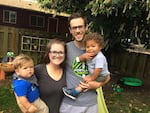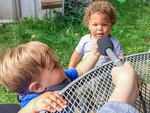Natalie and Loren Brenner didn’t mean for it to happen this way. They just got lucky.
A little over a year ago, they began the process to adopt a baby.
Then Natalie got pregnant. Then the couple got a call that the adoption had gone through.
"Basically we have always wanted to adopt, and we always also wanted to attempt for biological children. So we just did it at the same time, I guess," Natalie Brenner said. "We were just ‘whatever happens first, happens first.’"

Natalie and Loren Brenner with their sons, Ira and Sage.
Anna Griffin / OPB
Ira recently turned a year old. He’s a cute little guy with chubby pink cheeks and blond-brown hair that has a mind of its own.
His brother, Sage, is five months older. He’s just as round-cheeked as Ira, though his hair is a fantastic halo of curls.
They have a lot in common. They're toddlers, inquisitive, rambunctious and inclined to put just about anything — even, say, a radio microphone — in their mouths.
But they also have one other difference: Ira is white. Sage is black.
"We get a lot of funny looks and stares, lots of prolonged stares," Natalie Brenner said. "We definitely look a little unique."
"How does that work?" Loren Brenner said, quoting a frequent question they hear. "'So you're the nanny?'"
For most parents, having two sudden additions to the family would be a challenge. Natalie and Loren have an added puzzle to solve: How do two white parents from rural Oregon and Idaho prepare one of their sons for the realities of being a young black man in America?

Is this thing on? Ira, left, and Sage Brenner test the equipment.
Anna Griffin / OPB
"Especially with all of the shootings we see," Natalie Brenner said. "We have some neighbors down the road who are a little bit darker than him and not much, and we're talking quite frequently about how you can't have water guns or airsoft guns. We're talking about that now — when he's 1.
"Now he's the cute little brown boy, but in a few years, he'll look like he's 15 when he's 8, you know."
Natalie Brenner is a writer. Loren Brenner is studying to be an elementary school teacher. They’re both people of deep faith, and their friends and family have been uniformly positive about their mixed-race family. But even well-meaning white people can make mistakes.
"Already he’s been referred to as a thug, as though that's a cute thing," Natalie Brenner said. "It was people, white people we love and know. It was supposed to be, ‘Oh you cute little thug, you cute little gangster.’ But then my little white son is over there, ‘Oh, you cute little fat nerd,’ so it's like, ‘Oh, so this is how it's going to be.’"
Their strategy is to be color aware, not colorblind. That means stocking the house with children’s books in which kids of color are more than just sidekicks and best friends, keeping pictures of Sage’s birth parents around, talking to them both — even at this young age — about the things that make them each unique.
"My little sister took the boys to the park the other day, so I could work a bit, and a little girl said, 'Why is there one black one and one white one?’" Natalie Brenner said. "And her mom was like, ‘Shhhhh, you don't ask that question.’
"As white parents of white children, that perpetuates the shame in being a person of color when we're shushing our children about asking. She's 5, that little girl, she notices. It's OK to notice. It's not a bad thing. I wish that parent would talk to her kid about how all families are different. They need to know: all families are different, we don't need to match."